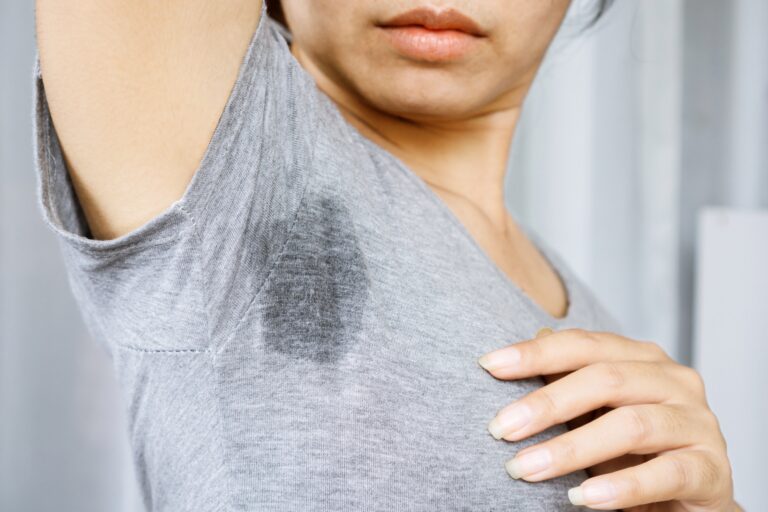body odour

A deeper look into body odour: causes, treatment and innovations
Body odour is an everyday phenomenon that affects us all. The science behind it is fascinating and innovations in this area are constantly evolving. In this blog post, we take a look at the origin of body odour, the substances involved, the different types of sweat and the advanced solutions that Symrise offers for this ubiquitous problem.
How does body odour develop?
Body odour is caused when sweat produced by the sweat glands comes into contact with bacteria on the skin. Sweat itself is odourless, but the bacteria on our skin break down the proteins and fatty acids contained in the sweat, which leads to unpleasant odours. The main bacteria responsible belong to the genera Micrococcus, Staphylococcus and Corynebacterium.
Which substances are responsible for body odour?
The development of body odour is closely linked to certain chemical compounds that are formed by bacterial activity:
– Steroids: e.g. 3-hydroxy-3-methylhexanoic acid (HMHA), which has a strong odour.
– Organosulphur compounds: these include androstenol and androstenone.
– Short-chain fatty acids: e.g. 3-methyl-2-hexenoic acid (3M2H), which have a particularly low odour threshold and can therefore be perceived even in small concentrations.
Types of sweat
There are two main types of sweat glands that produce sweat: eccrine and apocrine glands.
Eccrine glands: These are distributed throughout the body and produce a watery sweat that is mainly used for thermoregulation.
Apocrine glands: These are located in areas such as the armpits and groin and produce a more fatty sweat that, due to its composition, tends to contribute more to body odour.
Beneficial active ingredients from our partner Symrise
Symrise offers a range of active ingredients that have been specially developed to effectively combat body odour. A key product is SymDeo® B125, which has excellent antimicrobial efficacy against odour-causing bacteria. It is known for its long-lasting effect and its ability to support the natural microflora of the skin without disturbing it.
Consumer requirements for deodorants and antiperspirants
Consumers expect deodorants and antiperspirants to be long-lasting and free of harmful chemicals. According to current market research, customers prefer products that are labelled as “long-lasting”, “alcohol-free”, “dermatologically tested” and “environmentally friendly”.
SymDeo® B125
Chemical name: 2-Methyl-5-Cyclohexyl-Pentanol
Application concentration: Typically used in concentrations of 0.3% to 0.5% in deodorants.
Properties: SymDeo® B125 is known for its strong antimicrobial activity, especially against odour-causing bacteria such as Staphylococcus spp. and Corynebacterium spp. It is also microbiome-friendly and does not significantly disrupt the natural skin flora.
SymDeo PMD green
Basis: 100% bio-based carbon
Properties: This active ingredient is colourless and odourless, fully biodegradable and highly effective against microorganisms that cause body odour. It provides long-lasting odour control and is kind to the skin and the environment.
SymGuard® CD
INCI: Phenylpropanol, o-Cymen-5-ol, Decylenglykol
Area of application: This complex is used in body care products from head to toe, including oral hygiene, where it significantly reduces bad breath. It serves as an environmentally friendly alternative to conventional organohalogen systems.
Properties: SymGuard® CD is known for its antimicrobial efficacy and is considered safe and effective for use in a wide range of cosmetic and personal care products.
SymClariol
Chemical name: Decylene glycol
Properties: SymClariol® acts as a multifunctional emollient with antimicrobial properties and is particularly effective in foot care products to combat foot odour. It is also suitable for use in products that cover the entire body from head to toe.
Use concentration: Often used in concentrations of 0.3% in foot creams.
Innovations in the area of deodorants
The latest innovations in deodorants are focused on environmentally friendly formulations and packaging, the safety of ingredients and the improvement of the skin’s microbial diversity. One example of such an innovation is SymDeo PMD green, which is completely plant-based, biodegradable and alcohol-free.
Body odour is a complex issue influenced by biological, chemical and microbial factors. Symrise’s advanced solutions can meet both the immediate and long-term needs of consumers for effective and safe deodorant products.
Innovations in deodorants
The latest innovations in deodorants focus on environmentally friendly formulations and packaging, the safety of ingredients and improving the microbial diversity of the skin. One example of such an innovation is SymDeo PMD green, which is made entirely from plant-based ingredients, is biodegradable and contains no alcohol.
Body odour is a complex issue that is influenced by biological, chemical and microbial factors. Symrise’s advanced solutions meet both the immediate and long-term needs of consumers for effective and safe deodorant products.
Literature:
Deodorants and antiperspirants: New trends in their active agents and testing methods.
Teerasumran P, Velliou E, Bai S, Cai Q.Int J Cosmet Sci. 2023 Aug;45(4):426-443
The role of fragrance and self-esteem in perception of body odors and impressions of others.
Croijmans I, Beetsma D, Aarts H, Gortemaker I, Smeets M.PLoS One. 2021 Nov 15;16(11):e0258773.